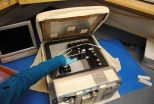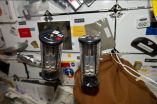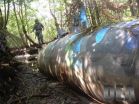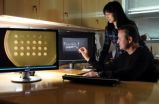HOUSTON, TX, September 11, 2012 (Press-News.org) Several young researchers were incredibly excited when the latest Japanese cargo ship arrived at the International Space Station, in late July. Along with the usual food, clothing, and science investigations, the spacecraft delivered the two global YouTube Space Lab winning entries.
Dorothy Chen and Sara Ma (from Troy, Mich.) and Amr Mohamed (from Alexandria, Egypt) won this opportunity to do research in the orbiting laboratory's microgravity environment -- while attending high school.
These young scientists are working on some interesting hypotheses involving jumping spiders' adaptation abilities, and how microgravity might affect the anti-fungal properties of Bacillus subtilis (also known as B. subtilis), which are naturally occurring bacteria.
Astronaut Sunita Williams, NASA flight engineer, is conducting the investigations aboard the station. The student experiments are scheduled to stream live via video from the space station on the YouTube Space Lab website Sept. 13, at 9:30 a.m. CDT.
Mohamed's Salticus scenicus, or zebra spider, research looks at whether jumping spiders, like the zebra and red-backed species, can adapt their hunting abilities to microgravity. Jumping spiders do not build webs for catching their food. These particular spiders hunt using their excellent vision to track and stalk prey, jumping and striking with a lethal bite -- similar to cats hunting mice.
"I have always been fascinated by science because with a handful of equations, I can explain the world around me," said Mohamed in his Meet the Winner YouTube video. "The idea of sending an experiment to space is the most exciting thing that I have ever heard in my life."
Chen and Ma were inspired by previous Salmonella studies done aboard station, proving this type of bacteria grown in microgravity becomes more virulent. They are testing this theory on B. subtilis, to see if these bacteria will have increased anti-fungal properties when compared to the same bacteria produced on Earth. Their testing procedures involve introducing various nutrients and compounds, in particular phosphates and nitrates, separately to see if these additives affect growth and anti-fungal potency. If their hypothesis is correct, results may lead to stronger probiotics (as B. subtilis is highly stable in harsh environmental conditions), and increased knowledge concerning how bacteria cause disease.
In their Meet the Winners YouTube video, Ma said, "When we first started brainstorming, we definitely wanted to do something to impact the human race. It's so cool how with science, everything relates to each other. Physics is used in chemistry, and chemistry is used in biology, and so on; everything is interrelated and it's just really neat to find those relations." Chen added, "The idea that something you made, something that's your experiment, being sent up into space and actually becoming a reality is pretty incredible."
Using the excitement of space and the thrill of having an experiment publicly conducted on the space station, exposes hundreds of thousands -- if not millions -- of students worldwide to the concept of research in microgravity, using the unique scientific platform of the space station.
The U.S. segment of the space station was designated as a national laboratory in 2005. NASA Deputy Administrator Lori Garver said, "As a national laboratory, our goal is to open up the space station to new paths for the exploration, discovery and economic development of space. Educating and inspiring the next generation of space explorers and scientists are among the most important things NASA can do, and these students are getting the opportunity of a lifetime. A contest like this taps into the passion of so many people who get involved, from the just over 2,000 students who submitted proposals to everyone who voted for them, and we want to encourage that passion and engagement."
The world-wide contest for students 14 to 18 years old called for students to submit entries via a two-minute YouTube video in the areas of physics or biology. There were over 2,000 entries received from more than 80 countries around the world.
"Competitions like YouTube Space Lab will inspire millions of people to explore and be curious about the world," said Mohamed.
For more information about the YouTube Space Lab contest and live downlink, visit:
http://www.youtube.com/user/spacelab/spacelab
For more information on past, ongoing, and future ISS research activities, including research results and publications, visit:
http://www.nasa.gov/mission_pages/station/research/index.html
If you are interested in subscribing to updates from the ISS Program Science Office, visit:
https://lists.nasa.gov/mailman/listinfo/iss-program-science-group
For more information about the International Space Station, visit:
http://www.nasa.gov/station
Student Biology Investigations Streamed Live from International Space Station
JR12-007
2012-09-11
ELSE PRESS RELEASES FROM THIS DATE:
Independents Stake Out Niche in Redbox Domain
2012-09-11
Redbox is not the only option for people who want to rent DVDs from kiosks at convenient locations and affordable prices. Independent operators like Bob Ennis and his partner Randi Haas, who live in Bucks County, PA near Philadelphia, are carving out a niche for their DVD rental kiosk business amid the Redbox machines.
"We're providing service for the little gems in rural areas, the under-served marketplaces that fall under the radar for Redbox, but still have a high volume of traffic," says Ennis, who acquired his three kiosks from a privately held company ...
LIMITED EDITION Miami Beach and Design Hotels Partner for the First Edition of the Hip New Travel Tradeshow
2012-09-11
Beyond Luxury Media and Design HotelsTM are excited to announce a partnership for the first edition of the innovative travel trade event, LIMITED EDITION Miami Beach (10 - 13 June 2013, Miami). Both companies passionately believe there is an urgent need for a new travel tradeshow that breaks away from the old concept of traditional luxury travel and creates a vibrant and fresh arena for those in the high-end Contemporary Travel market; a belief that will make this partnership so electrifying.
Created by Serge Dive and Sarah Ball, the Founders of Beyond Luxury Media and ...
Study provides first-time analysis of 3 distinct contributions of forage fish worldwide
2012-09-10
STONY BROOK, NY, Sept. 7, 2012– A just-published study provides a first-time analysis of the value of forage fish, which are small, schooling species such as sardines, herring, and anchovies. Three kinds of contributions of forage fish were estimated: as direct catch, as food for other commercially important fish, and as an important link in the food web in marine ecosystems. The analysis showed these small fish contribute a total of $16.9 billion, as both direct catch and food for larger fish, to global fisheries annually, representing 20 percent of the global catch values ...
Employees at 'green' companies are significantly more productive, study finds
2012-09-10
Bucking the idea that environmentalism hurts economic performance, a new UCLA-led study has found that companies that voluntarily adopt international "green" practices and standards have employees who are 16 percent more productive than the average.
Professor Magali Delmas, an environmental economist at UCLA's Institute of the Environment and Sustainability and the UCLA Anderson School of Management, and Sanja Pekovic from France's University Paris–Dauphine are the first to study how a firm's environmental commitment affects its productivity.
Their findings, forthcoming ...
Homeland Security's 'narco sub' PLUTO mimics the real thing
2012-09-10
The erstwhile planet Pluto (now officially an asteroid) was known for decades as a small, dark planet—hidden, difficult to spot, and on a quiet, determined course all its own. And so, when the DHS Science and Technology Directorate (S&T) needed a target semi-submersible to detect the hidden but determined maritime smuggling operations of the South American drug cartels, it created its own vessel and called it "PLUTO," after the planet that is so difficult to spot. S&T's PLUTO is a small, semi-submersible that is representative of what are popularly called "narco subs," ...
Tracing the molecular causes of preeclampsia
2012-09-10
Preeclampsia is one of the most dangerous conditions for the expectant mother and the unborn child and is characterized by elevated blood pressure and protein in the urine in the last trimester of pregnancy. The cause for this life-threatening disease has long remained elusive. Recently however, Dr. Ananth Karumanchi (Associate Professor of Medicine, Beth Israel Deaconess Medical Center & Harvard Medical School, Boston, Massachusetts, USA) has identified a new molecular pathway that leads to preeclampsia in humans and thus creating new avenues for the development of a therapy, ...
Researchers find first evidence for a genetic cause for Barrett's esophagus
2012-09-10
Genetic variations that are linked with the onset of Barrett's oesophagus (BE), a pre-cancerous condition of the lower end of the gullet, have been identified for the first time. The discovery of variations in regions on two chromosomes makes it possible to develop screening tests for people at high risk of developing the disease.
Although it's been thought for some time that there may be genetic causes for BE as well as environmental ones, such as drinking alcohol and eating fatty food, so far researchers have not found any genetic variations that are associated with ...
Genetic clues to the causes of primary biliary cirrhosis
2012-09-10
Researchers have newly identified three genetic regions associated with primary biliary cirrhosis (PBC), the most common autoimmune liver disease, increasing the number of known regions associated with the disorder to 25.
The team used a DNA microchip, called Immunochip, to survey more thoroughly regions of the genome known to underlie other autoimmune diseases to discover if they play a role also in PBC susceptibility. By combining the results from this survey with details of gene activity from a database called ENCODE, they were able to identify which cells types are ...
Uncovering the genome's regulatory code
2012-09-10
Since the sequencing of the human genome in 2001, all our genes – around 20,000 in total – have been identified. But much is still unknown – for instance where and when each is active. Next to each gene sits a short DNA segment, and the activity of this regulatory segment determines whether the gene will be turned on, where and how strongly. These short regulatory segments are as – if not more – important than the genes, themselves. Indeed, 90% of the mutations that cause disease occur in these regulatory areas. They are responsible for the proper development of tissues ...
Study identifies genes associated with genomic expansions that cause disease
2012-09-10
A study of more than 6,000 genes in a common species of yeast has identified the pathways that govern the instability of GAA/TTC repeats. In humans, the expansions of these repeats is known to inactivate a gene – FXN – which leads to Friedreich's ataxia, a neurodegenerative disease that is currently incurable. In yeast, long repeats also destabilize the genome, manifested by the breakage of chromosomes.
Working with collaborators at Tufts University, researchers at the Georgia Institute of Technology identified genetic deficiencies associated with the instability of ...
LAST 30 PRESS RELEASES:
Making lighter work of calculating fluid and heat flow
Normalizing blood sugar can halve heart attack risk
Lowering blood sugar cuts heart attack risk in people with prediabetes
Study links genetic variants to risk of blinding eye disease in premature infants
Non-opioid ‘pain sponge’ therapy halts cartilage degeneration and relieves chronic pain
AI can pick up cultural values by mimicking how kids learn
China’s ecological redlines offer fast track to 30 x 30 global conservation goal
Invisible indoor threats: emerging household contaminants and their growing risks to human health
Adding antibody treatment to chemo boosts outcomes for children with rare cancer
Germline pathogenic variants among women without a history of breast cancer
Tanning beds triple melanoma risk, potentially causing broad DNA damage
Unique bond identified as key to viral infection speed
Indoor tanning makes youthful skin much older on a genetic level
Mouse model sheds new light on the causes and potential solutions to human GI problems linked to muscular dystrophy
The Journal of Nuclear Medicine ahead-of-print tip sheet: December 12, 2025
Smarter tools for peering into the microscopic world
Applications open for funding to conduct research in the Kinsey Institute archives
Global measure underestimates the severity of food insecurity
Child survivors of critical illness are missing out on timely follow up care
Risk-based vs annual breast cancer screening / the WISDOM randomized clinical trial
University of Toronto launches Electric Vehicle Innovation Ontario to accelerate advanced EV technologies and build Canada’s innovation advantage
Early relapse predicts poor outcomes in aggressive blood cancer
American College of Lifestyle Medicine applauds two CMS models aligned with lifestyle medicine practice and reimbursement
Clinical trial finds cannabis use not a barrier to quitting nicotine vaping
Supplemental nutrition assistance program policies and food insecurity
Switching immune cells to “night mode” could limit damage after a heart attack, study suggests
URI-based Global RIghts Project report spotlights continued troubling trends in worldwide inhumane treatment
Neutrophils are less aggressive at night, explaining why nighttime heart attacks cause less damage than daytime events
Menopausal hormone therapy may not pose breast cancer risk for women with BRCA mutations
Mobile health tool may improve quality of life for adolescent and young adult breast cancer survivors
[Press-News.org] Student Biology Investigations Streamed Live from International Space StationJR12-007






